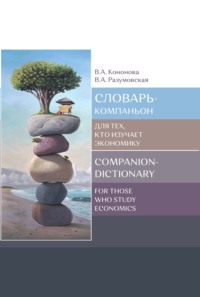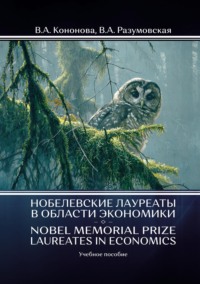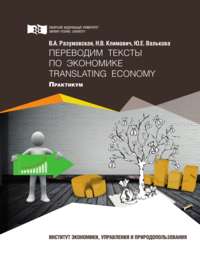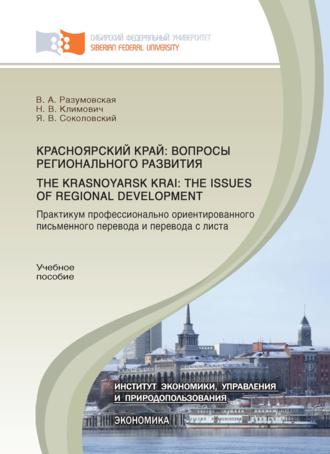
Полная версия
Красноярский край: вопросы регионального развития. Практикум профессионально ориентированного письменного перевода и перевода с листа.The Krasnoyarsk Krai: the Issues of Regional Development
4. Capital investment may also refer to a firm's acquisition of capital assets or fixed assets such as manufacturing plants and machinery that is expected to be productive over many years. Sources of capital investment are manifold, and can include equity investors, banks, financial institutions, venture capital and angel investors. While capital investment is usually earmarked for capital or long-life assets, a portion may also be used for working capital purposes.
5. We use a laboratory experiment to investigate how the level of a budget assigned to an employee by a firm owner affects employee effort. Consistent with reciprocity and fairness models, we find a negative relationship between budget levels and employee effort – many employees responded to a low budget with high effort and responded to a high budget with low effort. We observed higher levels of reciprocal behavior (i.e., lower budgets and higher effort) when the same employee-owner dyad interacted for multiple periods relative to dyads only interacting for a single period.
6. Business expenditures can be divided into capital and revenue expenditures. Capital expenditures are expenditures that produce benefits across multiple time periods, such as the costs to acquire and make ready for use long-term assets. In contrast, revenue expenditures are expenditures that produce benefits across one single time period such as the costs to acquire products intended for sale and to run the operations to sell those same products. Revenue expenditures are more often called expenses.
7. Interest payment represents a payment amount determined by the interest rate on an account. As a borrower, an interest payment represents the rate charged for being lent funds. As an investor, interest payments represent income on earned cash accounts or fixed and variable rate securities.
8. On results of the first half-year 18 banks have entered into the list of 1000 largest tax bearers of the country. It paid 3.84 billion drams into the state budget. According to State tax service RA, Unibank also has entered into the list of the largest tax bearers of the country. The Bank has taken 151st place. In general, Unibank paid 140.6 million drams in the state budget.
Task 6. Determine the key information in each paragraph of the text “Tax Climate in the Region” and the corresponding key concepts and English words and expressions; write them down in the language of the original text.
Task 7. Make an English annotation of the text “Tax Climate in the Region” (100–120 words), using the results of the previous Tasks 2–6.
Task 8. Translate the section of the text “Tax Climate in the Region” entitled “The investment tax credit” into Russian, using a dictionary if necessary.
Task 9. “Back-translate” your Russian translation into English. Compare your translation with the original text. Discuss both English variants of the section
“The investment tax credit”, paying particular attention to the key concepts and corresponding words and expressions.
Task 10. Give a gist intralingual translation (English into English) of the original text. Your translation should not exceed 1/3 of the original text size.
Task 11. Recast the gist translation of the text in different words, adapting it for high school students.
Text 3. Industrial and Economic Potential of the Krasnoyarsk Krai
Task 1. Read and study the following text.
By January 01, 2008 about 67.1 thousand economic entities operating in the Krasnoyarsk Krai were included into the State united list of the enterprises, organizations, their branches and other detached divisions. In 2008 the number of enterprises has increased by 1985 (by 3.1 %) in comparison with 2007.
Distribution of economic entities according to the types of property (by January 1. 2008), %
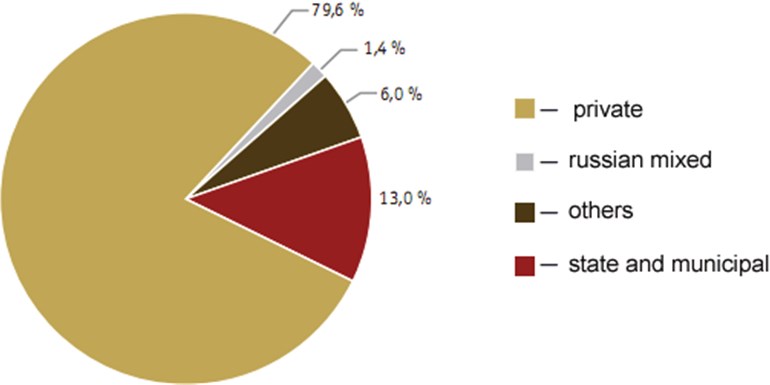
Small business development is one of the fundamental conditions of the market economy functioning. 15 879 small enterprises operated by October 1, 2007 in the Krasnoyarsk Krai with the total employees number of 124.1 thousand. The turnover of small businesses on all kinds of economic activities increased by 24.7 % and made up 155.2 billion rubles in comparison with 2006. The basic share of the small enterprises is concentrated in trade (48.7 %), construction (13 %), real estate (13 %) and processing industries (10.8 %).
In 2007 about 4 508.6 million rubles were invested into development of small business (the rate of growth is 130.5 % in comparison with 2006). The basic share of investments into small enterprises was directed into construction (67.5 %), real estate (22.2 %) and trade (6.5 %).
In 2007 small business entities with the support from the budget of the Krai realized 77 investment projects. 18 of them were chosen in 2007. The volume of debt capital investments in the 18 projects constitutes 2 180 ml. rubles, and due to realization of these projects 250 new work places were created in 2007. The Krasnoyarsk Krai is one of the most industrially developed regions of Russia. It has 3.2 % of the total amount of industrial goods produced in Russia. In 2007 the Krasnoyarsk Krai took the 1st place among the Siberian Federal District regions in All-Russian production sharing and shipped goods with its own production, accomplished work and services per capita.
Processing industries have the largest share – 86.1 %, with a predominant share of metallurgy and metal finished goods – 71.8 % among the types of economic activities of the Krasnoyarsk Krai.
Among the regions of the Siberian Federal District the Krasnoyarsk Krai has the leading position in amount of processing industries goods per capita.
Structure of the regional economy according to the types of economic activities
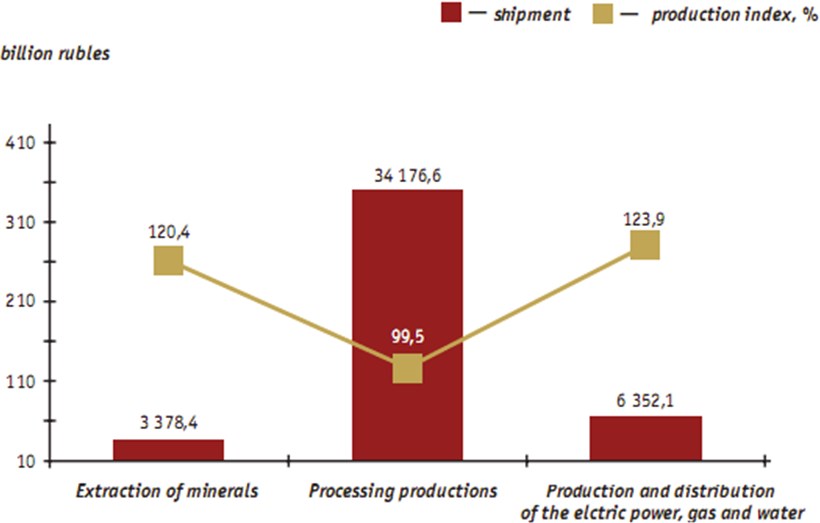
The economic activity of the Krasnoyarsk Krai specializes in:
• capital-intensive and energy-intensive production based on natural resources utilization;
• intermediate products manufacturing intended for export to other regions of Russia and abroad;
• export to the CIS and other foreign countries.
The tendency of economic development in the Krasnoyarsk Krai:
• specialization in export-oriented industries;
• certain increase in the share of extractive and processing industries due to realization of large investment projects in the spheres of extraction, fuel and energy resources, transport infrastructure, realization of complex development program of the Lower Angara River, including construction of the Boguchany hydro-electric power station;
• volume stabilization of the raw materials output;
• increase in ferrous and non-ferrous metallurgy production;
• intensive development of the services market related to culture, sports and tourism.
Competitive advantages of the region are determined by the economy specialization:
• large opportunities for wide cooperation with other regions and foreign countries; expansion of goods deliveries geography;
• wide opportunities for production diversification;
• opportunities for vertical integration of production on the basis of domestic raw mineral resources extraction and deep processing;
• innovation potential for development of new science-intensive, high-tech production with prompt return;
• keeping stable long-term demand to the main products on the world markets;
• developed system of financial-credit establishments;
• developed transport and communication structure.
Weak positions of the Krai:
• high dependence of the region on the world metal market prices;
• small production share of deep processing of timber and agricultural production;
• polluting manufactures;
• high degree of the capital assets depreciation.
Since 1998 the volume of the gross regional product (GRP) has increased:
• The Krasnoyarsk Krai is one of the ten donor regions which form more than 50 % of Russia’s Gross Domestic Product and federal budget.
• According to the latest statistic data, the Krasnoyarsk Krai ranks sixth among the 84 subjects of the Russian Federation in the gross regional product (GRP) volume. Region's share is more than 20 % of Siberia’s GRP and about 2.7 % of Russia’s GDP. GRP of the Krasnoyarsk Krai in 2007 was estimated in 721.2 billion rubles (+105.5 % in comparison with 2006). Industry (processing and obtaining) makes 60.4 % of GRP volume, transport and communication – 8.1 %, trade and services – 6.7 %, construction – 6.1 %, agriculture – 4.9 %.
For the economy of the Krasnoyarsk Krai 2007 was the year of moderate economic growth. The tendencies of growth of GRP, volumes of industrial out-put, employment of the population and real incomes of the population, observed during the last seven years in the Krai, continued.
In 2007 the volume of the shipped goods of own production, executed works and services according to the types of economic activities, extraction of the minerals, processing industries, production and distribution of the electric power, gas and water constituted 538.1 billion rubles. In comparison with 2006 it reached 104.4 %. In 2007 the rating of the Krai among the Russian Federation’s subjects, arranged according to physical volume index, improved. The Krai moved from the 68th (in 2006) to the 57th place (in 2007).
There are 6 large monopolistic producers in the Krasnoyarsk Krai:
• Polar division of JSC “MMC Norilsk Nickel”;
• JSC “RUSAL – Krasnoyarsk Aluminium Smelter”;
• JSC “The Gulidov Krasnoyarsk Non-ferrous Metals Plant”;
• CJSC “Polyus”Gold Mining Company;
• JSC “RUSAL – Achinsk”;
• OJSC “The Yenisei Territorial Generate Company (TGC-13)’’.
Source: http://www.krskstate.ru
Task 2. Find the word/expression in the right-hand column that could meaningfully replace one of the words/expressions on the left in English-Russian translation.

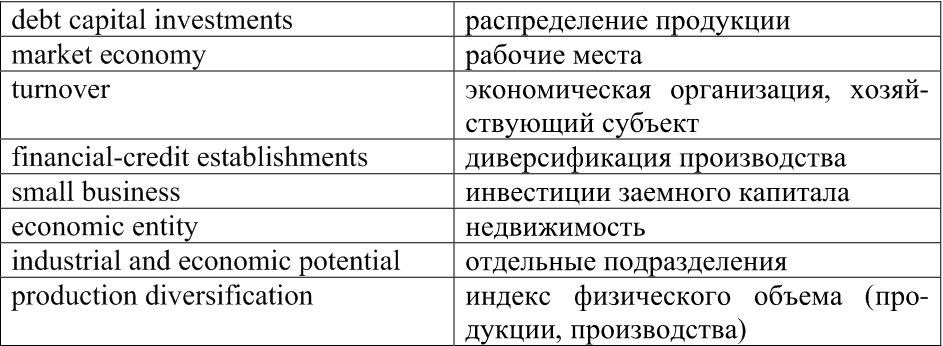
Task 3. Give the English translation equivalent of the following Russian words and expressions from the above text.
Деловая активность, развитие малого бизнеса, уровень роста, создать рабочие места, промышленно развитый регион, на душу населения, использование природных ресурсов, крупный инвестиционный проект, транспортная инфраструктура, гидроэлектростанция, рынок услуг, конкурентные преимущества, глубокая обработка, постоянный спрос, вертикальная интеграция, умеренный экономический рост, реальные денежные доходы населения, монополистические производители.
Task 4. Give the Russian translation equivalents of the following expressions with the keyword “production”.
Large-scale production, efficient production, annual production, domestic production, food production, livestock production, industrial production, to be in production, to go out of production, to increase production, to stop production, production line, production methods, production processes, production system, production director, production manager, production team, production costs, production capacity, successful production, amateur production, professional production.
Task 5. Translate the following mini-texts into Russian, using words and expressions from the above text and Tasks 2-4 or a dictionary if necessary.
1. Small businesses are common in many countries, depending on the economic system in operation. Typical examples include: convenience stores, other small shops (such as a bakery or delicatessen), hairdressers, tradesmen, lawyers, accountants, restaurants, guest houses, photographers, small-scale manufacturing, and online business, such as web design and programming, etc.
2. From what I know, a business that converts raw material into finished goods is a manufacturing business. There are many examples of manufacturing such as textile manufacturing, furniture manufacturers, and even food processors.
3. The best way to understand a country's economy is by looking at its Gross Domestic Product (GDP). This economic indicator measures the country's total output. This includes everything produced by all the people and all the companies in the country. To get everything produced by a country's citizens, no matter where they are in the world, you should look at Gross National Product (GNP), also called Gross National Income (GNI).
4. Turnover is the name for a measure of how quickly inventory is sold (inventory turnover). A high turnover means that goods are sold quickly, while a low turnover means that goods are sold more slowly. Asset turnover is a financial ratio that measures the efficiency of a company's use of its assets in generating sales revenue or sales income to the company. Turnover (employment), relative rate at which an employer gains and loses staff, especially in North American usage. Customer turnover, the rate at which a business loses customers, sometimes called the churn.
5. Market economies work on the assumption that market forces, such as supply and demand, are the best determinants of what is right for a nation’s well-being. These economies rarely engage in government interventions such as price fixing, license quotas and industry subsidizations. While most developed nations today could be classified as having mixed economies, they are often said to have market economies because they allow market forces to drive most of their activities, typically engaging in government intervention only to the extent that it is needed to provide stability.
6. In accounting, an economic entity is one of the assumptions made in generally accepted accounting principles. Basically, any organization or unit in society can be an economic entity. Examples of economic entities are hospitals, companies, municipalities, and federal agencies.
7. Real estate is property consisting of land and the buildings on it, along with its natural resources such as crops, minerals, or water; immovable property of this nature; an interest vested in this; (also) an item of real property; (more generally) buildings or housing in general. Also: the business of real estate; the profession of buying, selling, or renting land, buildings or housing.
Task 6. Determine the key information in each paragraph of the text “Industrial and Economic Potential of the Krasnoyarsk Krai” and the corresponding key concepts, words and expressions; write them down in the language of the original text.
Task 7. Find the Russian equivalents of the written down English words and expressions from the text “Industrial and Economic Potential of the Krasnoyarsk Krai” (Task 6).
Task 8. Translate the first seven paragraphs of the text “Industrial and Economic Potential of the Krasnoyarsk Krai” into Russian, using the words and expressions from Tasks 6–7 and a dictionary if necessary.
Task 9. Summarize in English the main ideas of the text
Конец ознакомительного фрагмента.
Текст предоставлен ООО «ЛитРес».
Прочитайте эту книгу целиком, купив полную легальную версию на ЛитРес.
Безопасно оплатить книгу можно банковской картой Visa, MasterCard, Maestro, со счета мобильного телефона, с платежного терминала, в салоне МТС или Связной, через PayPal, WebMoney, Яндекс.Деньги, QIWI Кошелек, бонусными картами или другим удобным Вам способом.




